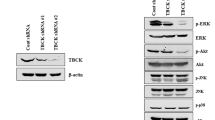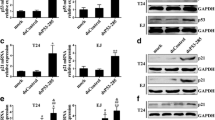Abstract
Purpose
Although there are many controversial reports about the effect of p53 and p21WAF1/CIP1 overexpression in different human tumor cells, the p53 gene is shown to be a more effective candidate for cancer gene therapy because of its more pronounced ability to induce apoptosis. In the present study, we present the effect of p53 and p21WAF1/CIP1 overexpression on mouse renal carcinoma cells in vitro and in vivo.
Methods
p53 and p21WAF1/CIP1 genes were introduced into Renca cells using adenoviral vectors (Ad5CMV-p53 and Ad5CMV-p21). The induction of apoptosis was measured using Annexin V assay and DNA fragmentation analysis. The expression of proteins was examined using immunocytochemistry and Western blot methods. The ability of adenoviral vectors to inhibit tumorigenicity of Renca cells, as well as the growth of pre-established tumors was measured.
Results
In vitro growth assays revealed higher growth suppression after Ad5CMV-p21 infection. Although both vectors induced apoptosis, Ad5CMV-p53 was slightly more efficient. In vivo studies in Balb/c mice, demonstrated that tumorigenicity was completely suppressed by Ad5CMV-p21. Besides this, Ad5CMV-p21 significantly inhibited the growth of established tumors, while Ad5CMV-p53 did not.
Conclusions
These data suggest that p21WAF1/CIP1 is a more potent growth suppressor than p53 of mouse tumor cells Renca. The divergent responses of tumor cells to p21WAF1/CIP1 overexpression could be due to various networks that differ between species.






Similar content being viewed by others
References
Cardinali M, Jakus J, Shah S, Ensley JF, Robbins KC, Yeudall WA (1998) p21(WAF1/CIP1) retards the growth of human squamous cell carcinomas in vivo. Oral Oncol 34:211–218
Clayman GL, Liu TJ, Overholt SM, Mobley SR, Wang M, Janot F, Goepfert H (1996) Gene therapy for head and neck cancer. Comparing the tumor suppressor gene p53 and a cell cycle regulator WAF1/CIP1 (p21). Arch Otolaryngol Head Neck Surg 122:489–493
D'Orazi G, Marchetti A, Crescenzi M, Coen S, Sacchi A, Soddu S (2000) Exogenous wt-p53 protein is active in transformed cells but not in their non-transformed counterparts: implications for cancer gene therapy without tumor targeting. J Gene Med 2:11–21
Dotto GP (2000) P21WAF1/CIP1: more than a break to the cell cycle. Biochim Biophys Acta 1471:M43-M56
Duttaroy A, Qian J-F, Smith JS, Wang E (1997) Up-regulated p21CIP1 expression is part of the regulation quantitatively controlling serum deprivation-induced apoptosis. J Cell Biochem 64:434–446
Eastham JA, Hall SJ, Sehgal I, Wang J, Timme TL, Yang, G Connell-Crowley L, Elledge SJ, Zhang WW, Harper JW, Thompson TC (1995) In vivo gene therapy with p53 or p21 adenovirus for prostate cancer. Cancer Res 55:5151–5155
Ekholm SV, Reed SI (2000) Regulation of G1 cyclin-dependent kinases in the mammalian cell cycle. Curr Opin Cell Biol 12:676–684
El-Deiry WS, Tokino T, Velculescu VE, Levy DB, Parsons R, Trent JM, Lin D, Mercer WE, Kinzler KW, Vogelstein B (1993) WAF1, a potential mediator of p53 tumor suppression. Cell 75:817–825
Evan GI, Vousden KH (2001) Proliferation, cell cycle, and apoptosis in cancer. Nature 411:342–348
Fotedar R, Brickner H, Saadatmandi N, Rousselle T, Diederich L, Munshi A, Jung B, Reed JC, Fotedar A (1999) Effect of p21waf1/cip1 transgene on radiation induced apoptosis in T cells. Oncogene 18:3652–3658
Gallagher WM, Brown R (1999) p53-oriented cancer therapies: current progress. Ann Oncol 10:139–150
Gartel AL, Serfas MS, Tyner AL (1996) p21-negative regulator of the cell cycle. Proc Soc Exp Biol Med 213:138–149
Gotoh A, Kao HC, Ko SC, Hamada K, Liu TJ, Chung LWK (1997) Cytotoxic effects of recombinant adenovirus p53 and cell cycle regulator genes (p21WAF1/Cip1 and p16CDKN4) in human prostate cancers. J Urol 158:636–641
Harper JW, Adami GR, Wei N, Keyomarsi K, Elledge SJ (1993) The p21 Cdk-interacting protein Cip1 is a potent inhibitor of G1 cyclin-dependent kinases. Cell 75:805–816
Herrmann M, Lorenz HM, Voll R, Grunke M, Woith W, Kalden JR (1994) A rapid and simple method for the isolation of apoptotic DNA fragments. Nucleic Acid Res 22:5506–5507
Hingorani R, Bi BY, Dao T, Bae Y, Matsuzawa A, Crispe IN (2000) CD95/Fas signaling in T lymphocytes induces the cell cycle control protein p21cip-1/WAF-1, which promotes apoptosis. J Immunol 164:4032–4036
Hollstein M, Shomer B, Greenblatt M, Soussi T, Hovig E, Montesano R, Harris CC (1996) Somatic point mutations in the p53 gene of human tumors and cell lines: updated compilation. Nucleic Acid Res 24:141–146
Joshi US, Dergham ST, Chen YQ, Dugan MC, Crissman JD, Vaitkevicius VK, Sarkar FH (1998) Inhibition of pancreatic tumor cell growth in culture by p21WAF1 recombinant adenovirus. Pancreas 16:107–113
Katayose D, Wersto R, Cowan KH, Seth P (1995) Effects of a recombinant adenovirus expressing WAF1/Cip1 on cell growth, cell cycle and apoptosis. Cell Growth Differ 6:1207–1212
Kralj M, Husnjak K, Körbler T, Pavelić J (2003) Endogenous p21WAF1/CIP1 status predicts the response of human tumor cells to wild-type p53 and p21WAF1/CIP1 overexpression. Cancer Gene Ther 10:457–467
Li Z, Rakkar A, Katayose Y, Kim M, Shanmugam N, Srivastava S, Moul JW, McLeod DG, Cowan KH, Seth P (1998) Efficacy of multiple administrations of recombinant adenovirus expressing wild-type p53 in an immune-competent mouse tumor model. Gene Ther 5:605–613
Nielsen LL, Maneval DC (1998) p53 tumor suppressor gene therapy for cancer. Cancer Gene Ther 5:52–63
Nielsen LL, Dell J, Maxwell E, Armstrong L, Maneval D, Catino JJ (1997) Efficacy of p53 adenovirus-mediated gene therapy against human breast cancer xenografts. Cancer Gene Ther 4:129–138
Noda A, Ning Y, Venable SF, Pereira-Smith OM, Smith JR (1994) Cloning of senescent cell-derived inhibitors of DNA synthesis using an expression screen. Exp Cell Res 211:90–98
Parker LP, Wolf JK, Price JE (2000) Adenoviral-mediated gene therapy with Ad5CMVp53 and Ad5CMVp21 in combination with standard therapies in human breast cancer cell lines. Ann Clin Lab Sci 30:395–405
Ramondetta L, Mills GB, Burke TW, Wolf JK (2000) Adenovirus-mediated expression of p53 or p21 in papillary serous endometrial carcinoma cell line (SPEC-2) results in both growth inhibition and apoptotic cell death: potential application of gene therapy to endometrial cancer. Clin Cancer Res 6:278–284
Roninson IB (2002) Oncogenic functions of tumor suppressor p21Waf1/Cip1/Sdi1: association with cell senescence and tumour-promoting activities of stromal fibroblasts. Cancer Lett 179:1–14
Roth JA, Cristiano RJ (1997) Gene therapy for cancer: what have we done and where are we going? J Natl Cancer Inst 89:21–39
Sekiguchi T, Hunter T (1998) Induction of growth arrest and cell death by overexpression of the cyclin-Ckd inhibitor p21 in hamster BHK21 cells Oncogene 16:369–380
Sheikh MS, Rochefort H, Garcia M (1995) Overexpression of p21 WAF1/CIP1 induces growth arrest, giant cell formation and apoptosis in human breast carcinoma cell lines. Oncogene 11:1899–1905
Sherr CJ (1996) Cancer cell cycles. Science 274:1672–1677
Shibata M-A, Yoshidome K, Shibata E, Jorcyk CL, Green JE (2001) Suppression of mammary carcinoma growth in vitro and in vivo by inducible expression of the Cdk inhibitor p21. Cancer Gene Ther 8:23–25
Stewart ZA, Pietenpol JA (2001) p53 signaling and cell cycle checkpoints. Chem Res Toxicol 14:243–263
Tsao Y-P, Huang S-J, Chang J-L, Hsieh J-T, Pong R-C, Chen S-L (1999) Adenovirus-mediated p21Waf1/Cip1 gene transfer induces apoptosis of human cervical cancer cell lines. J Virol 73:4983–4990
Vousden KH (2000) p53: Death star. Cell 103:691–694
Wallace-Brodeur RR, Lowe SW (1999) Clinical implications of p53 mutations. Cell Mol Life Sci 55:64–75
Yang ZY, Perkins ND, Ohno T, Nabel EG, Nabel GJ (1995) The p21 cyclin-dependent kinase inhibitor suppress tumorigenicity in vivo. Nature Med. 1:1052–1056
Zhang WW (1999) Development and application of adenoviral vectors for gene therapy of cancer. Cancer Gene Ther 6:113–138
Zhang WW, Fang XM, Mazur W, French BA, Georges RN, Roth JA (1994) High-efficiency gene transfer and high-level expression of wild-type p53 in human lung cancer cells mediated by recombinant adenovirus. Cancer Gene Ther 1:5–13
Acknowledgement
This work was supported by grant 0098092 from the Ministry of Science and Technology, Republic of Croatia. We thank Mihaela Alivojvodić for expert technical assistance, and Dr. Anđelko Hrženjak and Dr. Saša Frank for useful discussions.
Author information
Authors and Affiliations
Corresponding author
Rights and permissions
About this article
Cite this article
Kralj, M., Pavelić, J. p21WAF1/CIP1 is more effective than p53 in growth suppression of mouse renal carcinoma cell line Renca in vitro and in vivo. J Cancer Res Clin Oncol 129, 463–471 (2003). https://doi.org/10.1007/s00432-003-0458-2
Received:
Accepted:
Published:
Issue Date:
DOI: https://doi.org/10.1007/s00432-003-0458-2




